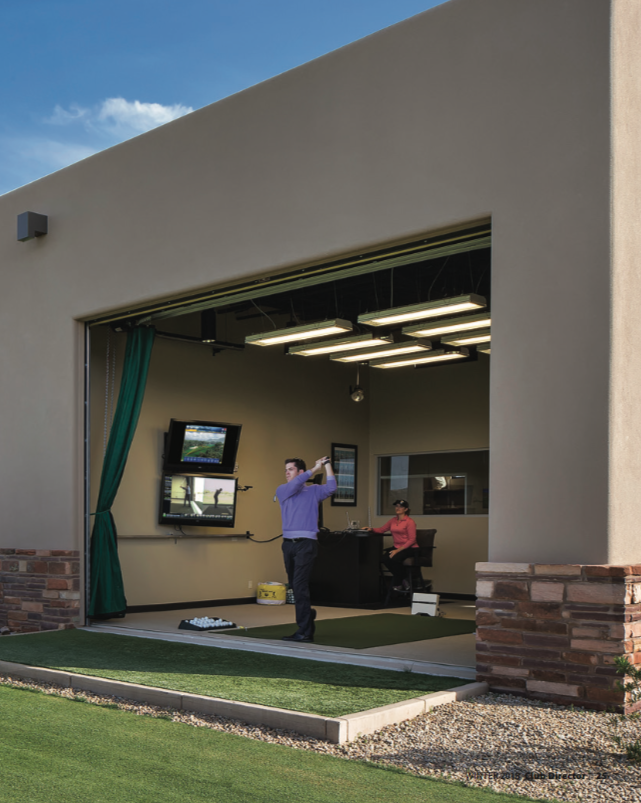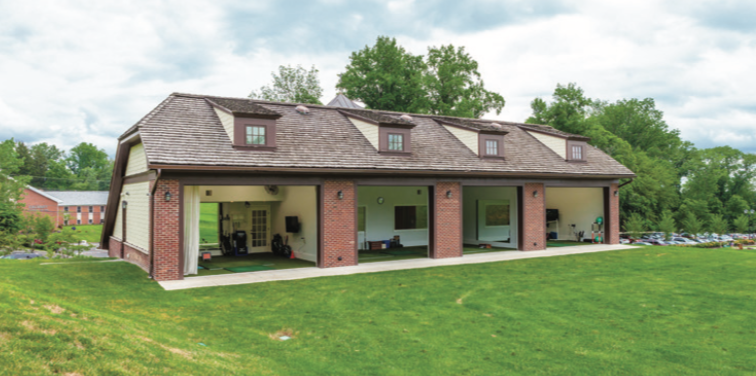As sports technology evolves and new instructional devices, monitors and simulators emerge to aid golfers with their game, clubs are responding to the need to create indoor golf performance facilities that integrate with their driving ranges, short game practice areas, and putting greens. Giving club members year-round access to climate-controlled golf practice areas and high-tech training centers is on the rise. This trend bodes well for growing the game as well as increasing member satisfaction with their access to individual analysis and instruction.
The rise in popularity of indoor facilities that provide off-course golf participation in a relaxed and unintimidating way is good for golf in many ways. In the U.S., the leader is Topgolf, whose entertainment and event venues offer golf games for all skill levels. Topgolf’s 38 locations entertain and introduce golf to more than 13 million guests annually, 37 percent of whom are nongolfers. Topgolf can be credited with shining a spotlight on the various innovative ways to participate in golf without having to play 18 holes.
According to a 2017 pulse survey of club executives conducted by McMahon Group and the National Club Association, 27 percent of respondents’ clubs offer an indoor hitting facility, which is up from 11 percent in 2009, and 17 percent have a golf performance center. Nineteen percent of respondents have golf simulators at their club. Of these, 47 percent offer leagues or programs using the simulators for their members, and 38 percent have a social gathering space around the simulators. Among the clubs that don’t have simulators, 34 percent of respondents said there is a demand from the membership to add them.
 The Time Factor and Family Fun
The Time Factor and Family Fun
Desert Mountain Club in Scottsdale, Ariz., is home to the 6,500 square-foot Jim Flick Golf Performance Center, named for one of the game’s greatest instructors and Desert Mountain’s PGA director of instruction from 1987-2005. As the only place in the world with six Jack Nicklaus signature courses, they host 145,000 rounds per year and the performance center sees more than 3,000 lessons. They are currently building a 3,004-yard, 18-hole championship short-game course where members can enjoy a full round in two hours.
Desert Mountain addresses its members’ golf instructional needs including technique, golf fitness and mental game performance by utilizing 3-D Doppler launch monitors that track and measure ball flight and club data; a real time, marker-less, gesture recognition training and teaching system; a Science and Motion Balance Lab; AMM 3-D sensor; and a Quintic Ball Roll.
Damon DiOrio, CCM, CEO, at Desert Mountain, feels that both the performance center and the short-game course capture the latest trends in golf and the club industry. He sees these new assets as amenities that have a positive impact on members’ lives and give them unique ways of experiencing the joys of golf rather than as profit centers. He noted that the main benefit is member engagement and satisfaction year-round, and providing social, interactive avenues that are fun for all levels of play.
DiOrio observed, “Golf is a beautiful game, but the next generation of club member views time as their most precious asset so we have had to evolve to have highly social, engaging, golf options—in addition to championship 18-hole golf courses—for everyone in the family to enjoy that don’t require the time commitment a round of golf requires.”
The Best Golf Experience Possible for Members
Southern Hills Country Club in Tulsa, Okla., is an iconic club that has hosted four PGA championships, three U.S. Open Championships and many USGA and other prestigious events. The club is gearing up for a $19 million renovation project whereby noted golf course architect Gil Hanse will renovate and restore its Perry Maxwell-designed championship course and practice facilities, add a short-game practice area and build a state-of-the-art indoor teaching facility. The course will close August 1, 2018, and reopen in June 2019.
The Southern Hills golf project will include: an overhaul all practice facilities, a new bag-and-cart storage building, renovated golf parking lot and staging areas. The new 3,200-foot practice facility will have four bays with TrackMan, golf simulators, SAM PuttLab, V1 coaching system and custom fitting.
Nick Sidorakis, CCM, GM/COO at Southern Hills said the idea for the performance center has been on his radar for six years, but the project is part of a master plan to upgrade all the club’s facilities and provide the amenities its 950 members want.
“Our members are very active on the golf course and we’ve just experienced two record years in terms of rounds played. The idea behind the new facility and upgraded golf amenities is to improve the golf experience for our members. When providing golf instruction, the more accurate the feedback, the better the improvement, the better the golf experience.”
Cary Cozby, Southern Hills’ PGA director of golf and 2016 PGA Professional of the Year, added, “We have four distinct seasons here and it makes sense for us to look for ways to get our golfing members to get a club in their hands. With simulators, you can come in and simulate and practice and improve anytime. We’ll become a year-round golfing facility.”
Sidorakis and Cozby agreed that time commitment is a major driver of this trend. Many members are so busy that they may not be able to commit the time for 18 holes on grass, but they want to practice their short game, get some instruction, or hit a bucket at the targets on the driving range.
When Cozby arrived at the club in 2015, he said the leadership was on the same page about the need for the performance center and the eventual hiring of a director of instruction, who will help him beef up the already-robust junior program; conduct more clinics; and use the equipment and instruction to provide more in-depth analysis to members.
The club reached out to peers in the golf and club management industries for research and advice. Cozby adds, “We have a great relationship with Tim Cutshall, who is the industry leader and a well-respected consultant in designing and outfitting learning and coaching centers at clubs, dealing with equipment manufacturers, and developing golf programs. He has been instrumental in the process.”
 Making Members Better
Making Members Better
 Baltusrol Golf Club, located 20 miles west of New York City, is a 120-year-old club with 36 holes of championship golf and a tradition of hosting world-class golfers and 17 professional championship tournaments. The dual courses are consistently ranked among America’s 100 Greatest Golf Courses by Golf Digest. Baltusrol is a Certified Audubon Cooperative Sanctuary and listed on the National Register of Historic Places and designated as National Landmark.
Baltusrol Golf Club, located 20 miles west of New York City, is a 120-year-old club with 36 holes of championship golf and a tradition of hosting world-class golfers and 17 professional championship tournaments. The dual courses are consistently ranked among America’s 100 Greatest Golf Courses by Golf Digest. Baltusrol is a Certified Audubon Cooperative Sanctuary and listed on the National Register of Historic Places and designated as National Landmark.
When the iconic club embarked on the design of its performance center, they too relied on the expertise and guidance of Tim Cutshall. The state-of-the-art, two-story center opened in 2010 and has two teaching bays, two practice bays, and integrates with an improved driving range with two tee boxes and two short game practice areas, including a 150-yard wedge range. This facility incorporates a 2,000 square-foot fitness area. Baltusrol employs a sports trainer who specializes in golf fitness, but because the facility is utilized by the entire membership, they offer an array of classes, programs and tailored opportunities for all member needs.
“We have about 1,400 members; 525 are full golfing members and another 300-400 have access to the golf course. Last year, members enjoyed 35,000 rounds. Golf is really central to us here at Baltusrol, so this evolution of practice greens and instruction opportunities seemed natural,” said Ryan Fountaine, PGA director of golf.
Fountaine says the packed schedule of their world-class Director of Instruction Jason Carbone, PGA, a Golf Magazine Top 100 Teacher since 2007, is illustrative of the club serving the needs of its members and responding to the demand for opportunities to play golf without having to play a whole round. Carbone’s office is in the performance center and he is ever-present. Additionally, the club employs six assistant professionals, all of whom provide instruction, and last year the members logged more than 5,000 hours of private golf lessons.
Fountaine said, “The impetus and driving force behind the facility and the upgrades is that more players are playing better golf. More members are satisfied with their golf games. People who desire the instruction, have access to it and see results.”
Kevin Vitale, CCM, GM/COO, notes that the golf amenities are not significant revenue streams, but the club is able to pay the PGA professionals higher salaries due to the programs’ popularity. This is a win-win as they can attract top-talent to the club and provide stellar coaching.
Bridging the Gap and Sharing Knowledge
Luke O’Boyle, CCE, GM/COO at Chevy Chase Club in the Maryland suburbs of Washington, D.C., is gearing up for an ambitious undertaking at the historic property. He said that the club recognized the need for an all-weather, year-round facility about ten years ago while strategizing a master plan. They will break ground in January and plan to have the free-standing facility located at the end of their driving range up and running in June.
“Our members have the ability to swim indoors locally in the winter and play tennis indoors here at the club, but there has always been this gap over the winter where they could rarely pick up their clubs. Now there will be year-round access to a climate-controlled facility to work on all aspects of the game and get enhanced instruction, too. We expect it to be quite popular among all of our golfing constituencies.”
The building will include five bays; two will be dedicated primarily for instruction with a staff member and three for members to use on their own. O’Boyle said they will install one simulator to start with, but have built into the design space for another in the future.
The club leadership did their due diligence by visiting several clubs with indoor golf centers, identifying and taking pictures of elements they liked, and coming up with a wish list of technology, design and aesthetics. They then consulted with Tim Cutshall, who developed a design proposal incorporating the club’s desires with recommendations for layout, materials, lighting and equipment. O’Boyle said he had many conversations with his industry peers and, when appropriate, reviewed others’ plans. That research was an invaluable part of the process.
“Look,” O’Boyle reasoned, “golf has become a game of practice. If people don’t have five hours, then anything clubs can do—whether that’s creating interesting short courses, enhancing putting and chipping areas, or installing simulators so that a member and three of his friends can play Pebble Beach on a Tuesday afternoon in January, then we need to look at providing those things.”
Bridget Gorman Wendling is a regular contributor to NCA publications. She can be reached at [email protected].


